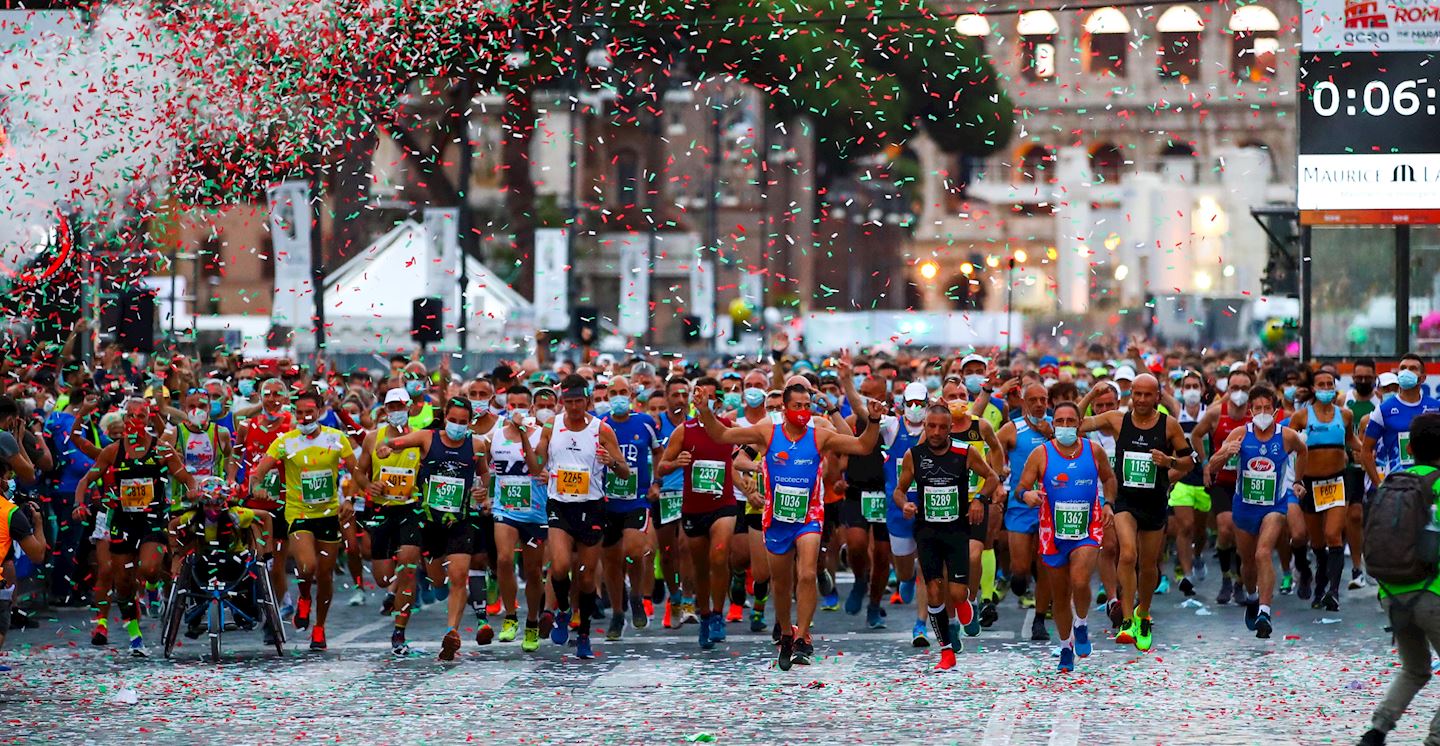How Soon Can I Run My Next Marathon?

Generally speaking, runners should not run more than two marathons a year. If you recently ran a marathon at your top speed and at your full potential, it's best to wait a period of four to six months before racing another.
A good rule of thumb is the harder you run a marathon event, the longer you should wait before running your next.

Considerations for Running Multiple Marathons a Year
The limit of two marathons per year is roughly based on conventional wisdom and research showing skeletal muscle damage, a severely compromised immune system, and oxidative DNA damage to the body of marathon runners after the completion of a 26.2-mile race.2
Muscle damage and inflammation in the body can last around seven days after a marathon.3 Muscles can take anywhere from three to 12 weeks to repair themselves, leaving you susceptible to tears, muscle collapse, muscle strain, or muscle cramps during that time.4 After a marathon, your body releases cortisol to reduce swelling,5 compromising your immune system as a result. Resting and taking a much-needed break from running is essential for recovering from the damage caused by running a marathon. To reduce the chance of injury and prevent further damage, after a marathon, many elite runners take two weeks off from running. They then take two additional weeks to ease back into training with very easy, light runs.
Deciding on Your Timeline
Listen to your body. Running a marathon places a lot of stress on the body, even if you don't feel particularly sore or run down, which is why it really is best to wait before competing in another marathon so soon after your last race.
با مربیان دو و متخصصان پزشکی صحبت کنید تا مشخص کنند که آیا دویدن در چند ماراتن برای شما بیخطر است و اگر چنین است، بین آنها چه مدت زمان باید فاصله باشد.
شاید بهتر باشد مسابقات کوتاهتری را بدوید و سپس به تدریج به ماراتنی که 4 تا 6 ماه دیگر است، برسید.
علیرغم آگاهی از خطرات، دوندگان ماراتنی وجود دارند که دو یا چند ماراتن را در سال و در برخی مواقع پشت سر هم میدوند. اگر احساس میکنید که سطح آمادگی جسمانی شما در حد این چالش است، نکات زیر را برای جلوگیری از آسیب دیدگی مد نظر قرار دهید.
Plan for the Year Ahead
Select your marathons well in advance so you can plan your training around them. Remember that running is cumulative. You won't train for 26.2 miles over 18 to 22 weeks, then repeat the same sequence immediately after running the first marathon. Your fitness level and running capacity will have increased and your body require a slightly different training schedule that accounts for the long run you just finished.

Take Time to Recover
Take at least three weeks to let your body recover before you start another marathon training schedule.1 That means no hard workouts or really long runs. Regardless of how hard you ran and how much soreness you experience, running 26.2 miles takes a toll on your body and it's important to take the proper steps for recovery.
Muscle soreness usually diminishes a few days after running a marathon, but your muscles will still need time to rebuild and rebound, which may take anywhere from three weeks to 12 weeks. Follow a "reverse tapering" schedule, where you slowly ease back into running.
Your recovery plan should also include the proper nutrition to repair tissue damaged during both the marathon and your training. Follow a balanced, whole foods diet high in protein and the adequate carbohydrates and fats you need to get you back to peak performance.6 The sooner your body can recover, the sooner you can jump back into training for the next big race.

Eat Well
For recovery, drinking plenty of water and opting for a diet high in protein, fatty acids, and vitamin C is essential for rebuilding muscle tissue and reducing inflammation in the body. The following foods are high in protein and can aid in your recovery:
- Lean beef
- Fish
- Poultry
- Low-fat dairy products
- Beans
- Nuts and seeds
- Eggs
- Whole grains such as whole wheat and jasmine or basmati rice
Fatty acids can be found in cold water fish such as salmon, nuts, seeds, olive oil, and avocados.
Vitamin C can be found in green leafy vegetables and many fruits.
Once you have returned to training, increase your carbohydrate intake (carbs are found in whole grains, rice, fruits, and vegetables).

Assess Your Pace and Effort in Your Last Race
If you took it easy during the marathon and ran it as a training run or for fun—and you don't have any lingering pain—then you should be OK to run another marathon in about 4–6 weeks after your marathon.
Keep in mind that you should only consider running a second marathon so soon after the first if your training for the first race had you logging four to five runs a week, amounting to about 40 to 45 miles per week. You should have also logged at least one long run of 16 to 20 miles in your training.
If you are waiting for more than four weeks after your last marathon, make sure you take it easy for at least two weeks, and then pick up with your marathon training schedule for the remaining weeks.
Include a Variety of Distances
Just because you ran a full marathon doesn't mean that's the only type of race you must, or should, stick to.
Doing 5K, 10K, and half-marathon races between full marathons can help you develop your speed work while improving your VO2 max (the maximum amount of oxygen that can be delivered and used for cardiovascular exercises by your body).
You will not increase your VO2 max if you always run the exact same distance, at the exact same pace, for the exact same time each time you run.
Luckily, you don't have to wait six months after running a full marathon to run a 5K or 10K race. If you are itching to enter a race soon after completing a full or half marathon, waiting four to six weeks before partaking in a fun run should be sufficient time to allow your muscles some recovery from your full marathon.

Adjust Your Expectations
You shouldn't necessarily aim for a PR in every race you enter. If you are running two marathons back-to-back with less than eight weeks in between, adopting a "less than peak performance" mentality is a good idea. Think of your subsequent run as a fun run. Doing so will allow you to pace yourself and reduce the amount of damage to your body.
Even though you shouldn't expect a personal record every time, there are ways to structure your training schedule so that you don't hinder your recovery period, continue to improve your energy systems, and develop your aerobic capacity.

Consider this sample training schedule for completing two marathons, and a few shorter races, all within one year.
Sample Training Schedule for Multiple Races Per Year
| یک تمرین ماراتن پیشرفته 16 تا 20 هفته ای را دنبال کنید. برنامه ریزی کنید؛ روی توسعه VO2 max خود کار کنید، میزان مسافت دویدن خود را افزایش دهید و کراس ترینینگ جلسات اینتروال را در برنامه خود بگنجانید. | July to November |
| Participate in a full 26.2 mile marathon. | November |
| Rest and ease back with very easy, light runs for about two weeks. | November to December |
| Begin recovery training. Be sure to include strength training and stride work. | December to January |
| Spend the next four weeks working on speed by concentrating on drills and interval training. | January |
| Participate in a 5K or 10K race. | End of January to February |
| Fall back into week 10 to 12 of your original marathon training schedule. | February to May |
| Participate in second full 26.2 mile marathon. | Mid-May |
| Rest and ease back with very easy, light runs for about two weeks. | End of May |
| Begin recovery training. Be sure to include strength training and stride work. | June to July |
| Spend the next four weeks working on speed by concentrating on drills and interval training. | July to August |
| Participate in a 5K or 10K race. | August to September |
| 2 weeks of recovery and light runs. | September to October |
| Change things up. Jump into half-marathon training. This is a good way to maximize your anaerobic threshold before reverse tapering and going back to training for another 26.2 mile marathon in six months. | October to December |
Avoid Burnout
Running multiple big races back-to-back is certainly not for the faint of heart. Even the most advanced runners will find that they have to change up their training strategy to continue making gains.
Do remember that just as scheduling rest days is critical for recovery, injury prevention, and burnout,10 so is waiting a healthy amount of time between running full marathons.



